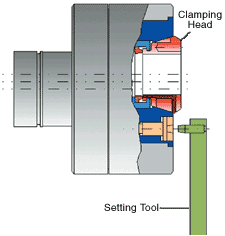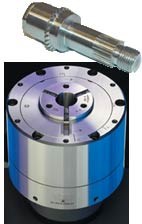Turning Off-Center Diameters In One Setup
In the past, turned parts with one or more off-center hubs could not be machined in one chucking on a lathe or turning center. Typically, the part had to be rechucked in a special fixture to center the eccentric portions for turning. Parts with more than one eccentric hub required additional refixturing.
Share








ECi Software Solutions, Inc.
Featured Content
View MoreIn the past, turned parts with one or more off-center hubs could not be machined in one chucking on a lathe or turning center. Typically, the part had to be rechucked in a special fixture to center the eccentric portions for turning. Parts with more than one eccentric hub required additional refixturing.
A new line of eccentric chucks being offered in the United States by Hainbuch Welge Corporation (Milwaukee, Wisconsin) solves this problem. Parts with one or several off-center hubs, such as the one in the picture below, can be machined in one setup on turning centers with a programmable C axis.
How this is accomplished becomes evident by studying the the face of the eccentric chuck. The clamping head, which grips the workpiece, is a self-contained unit that is built into a larger eccentric cylinder within the outer body of the chuck. The center of the clamping unit is not on center with the eccentric cylinder, and the eccentric cylinder is not, in turn, on center with the outer body of the chuck.
However, by rotating and locking the eccentric cylinder, the center of the clamping unit can be aligned with the centerline of the spindle. In this position, of course, a workpiece can be turned on center. By unlocking and rotating the eccentric cylinder, the off-center diameters of the workpiece also can be lined up on center with the spindle. Although this adjustment can be made manually, the Hainbuch eccentric chuck is designed so that a setting tool mounted in the tool turret can make the adjustment automatically.
When the setting tool is deployed, its actuator engages a mating pocket on the face of the eccentric cylinder, as seen in the diagram above. The actuator unlocks the eccentric cylinder, allowing it to rotate with programmed movement of the C axis. The distance that the C axis moves determines the offset of the cylinder so that it matches that of the off-center diameter on the part. Adjustments can be made in stepless increments from 0 to 15 mm (0.59 inch) off center.
After the setting tool retracts, the eccentric cylinder returns to its locked condition so that normal cylindrical turning of the off-center diameter can commence. Additional off-center hubs can be machined by readjusting the position of the eccentric cylinder as many times as needed.
The eccentric chuck uses the standard hydraulic clamping cylinder in the lathe, so no modifications to the machine are required. Gripping force on the workpiece is maintained during adjustments, so it does not lose position. According to Harold Welge, president of Hainbuch Welge Corp., the chuck is designed to maintain balance and minimize vibration when turning in eccentric positions. Two sizes of the eccentric chuck are currently available in the United States, a 42-mm and a 65-mm model.
Related Content
-
Using Automation to Reduce COGS and Stay Globally Competitive
Decade-long, multiphase automation investments lower operating costs and maintain technology lead in an increasingly competitive global market.
-
Using Jaws as Grippers Enables Flexible, Low-Cost Automation
VersaBuilt’s automation systems significantly boosted Innovative Fabrication’s revenue. In return, the shop has helped VersaBuilt optimize its products.
-
Navigating Large-Scale CNC Machining: Suburban Tool’s Niche Strategy to Stay Competitive
Facing increasing competition from lower-cost imports, Suburban Tool made a move toward large-scale, in-house machining. By identifying a niche in large, precision angle plates and tombstones, the company has strengthened its ability to control quality and protect its reputation.
























.png;maxWidth=150)
















